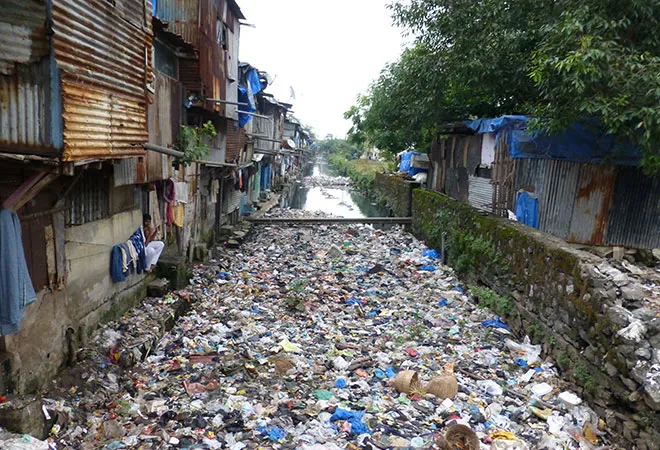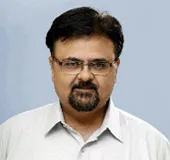
Around 6:30 AM on April 28, Babubhai Devji (40) and Lauben Jethwa (42) stepped into the MAHDA toilet block in the Saisadan Chawl in Bhandup, a northern suburb of Mumbai. Suddenly, the floor of the toilet block – standing directly over a filled-to-capacity eight-feet-deep septic tank – collapsed, plunging both Babubhai and Lauben into human excreta below. They drowned. Their bodies were fished out by fire brigade and National Disaster Response Force (NDRF) personnel after a difficult seven-hour operation.
Activating the specialised task force meant for large-scale national-level rescue operations for toilet block collapses suggests the seriousness of what happened in Bhandup. And given the frequency of such gruesome tragedies, this shameful incident shows how sanitation problems have reached catastrophic proportions in Mumbai.
Eleven innocent lives, including those of three children, have been lost in toilet disasters in Mumbai since 2013. The toll goes up to 16, if one takes into account toilet-related deaths across the metropolitan region. While a majority of the deaths have happened because of drowning in septic tanks following structural collapses, exploding septic tanks which have not been desludged for decades, leading to accumulation of methane, have also killed and maimed people.
Such inhuman tragedies occurring in Mumbai with almost predictable regularity indicate that they are no longer mishaps – they are systemic crimes. However, slum sanitation continues to feature nowhere on the priority list of either the government or the Municipal Corporation of Greater Mumbai (MCGM).
The disconnect of the political class and administrators with the shocking ground reality is evident as instead of tackling this scourge on a war footing, they are singing paeans about Mumbai gaining open defecation-free status.
Nearly 50 lakh residents of the city’s notified slums (slums which existed before the 1995/2000 cut-off date of the Slum Rehabilitation Scheme and therefore eligible for free housing under the scheme) are served by 750-odd community toilet blocks constructed under the World Bank-initiated Slum Sanitation Programme (SSP). These toilets have 26,379 seats, which approximately means one toilet seat to be shared by 190 users, as against the MCGM-accepted WHO norms of one toilet per 50 people. This overwhelming load is reduced by those who use the nearly 30,000-odd free-to-use MHADA toilets, those who can afford to daily use the other pay-and-use facilities, and those who defecate in the open.
No wonder, user pressure on the SSP toilets, run on a community participatory model, is immense, to say the least. It is common to find long queues of men and women outside these toilets, waiting for their turn. Many have to walk long distances from their homes to reach the toilet block. Often, the area around toilet blocks become hangouts for alcoholics, addicts and gamblers. Women and young girls become extremely vulnerable, as they fall prey to lewd remarks and other forms of physical and sexual harassment.
To avoid such daily disgrace, many are forced to venture out for their daily ablutions in groups, looking for secluded spots in the neighbourhood under the cover of darkness.
An MCGM survey of SSP community toilets conducted in 2016 revealed that 58 percent have no electricity, while 78 percent have no water. Whereas the MHADA toilets – constructed solely out of the local area development funds of councillors, MLAs and MPs – by design, do not have either water or electricity connections. These toilets are dangerous to use at night.
All pay-and-use toilets, on the other hand, are run as businesses. Their humanitarian aspect is eclipsed by political and other vested interests at the cost of maintenance and service delivery. For local politicians, the toilet business helps in extending their sphere of influence over their vote bank. For MCGM and power distribution companies, its good business, as these toilets ensure recovery of commercial water and electricity tariffs. In several slums, therefore, open defecation is actually the preferred or the only available option, as most people are unable to either afford the pay-and-use facilities, or use the filthy and perennially clogged MHADA toilets.
The problem is compounded by the emergence of multiple agencies that have jumped into the fray with convenient legislative mandates, but zero accountability. Toilets are constructed by MCGM, MHADA’s Slum Improvement Board, several private agencies like Sulabh International, and even NGOs like SPARC and Pratha (for SSP), but none of these is accountable for their maintenance. The latest entrant in the fray is MMRDA, the state government’s planning authority, which has started construction of toilets under the Nirmal MMR Abhiyan across all municipal areas in the metropolitan region (except in Greater Mumbai) at a projected cost of Rs. 300 crore.
Shared sanitation facilities are falling miserably short in serving the basic needs of the city’s millions of slum dwellers. With improved earnings of individual slum families, education, and rising aspirations for a better quality of life, there is a growing demand for sanitation systems that are more hygienic, efficient and cost effective and especially those that cater to the inevitable privacy of users.
The only assured sustainable solution is provision of individual toilets. Though families are willing to spend their own money to construct such in-house facilities, the task is full of hurdles and corruption.
Applications are turned down by civic engineers on flimsy technical grounds without even conducting a single site visit. As a result, despite individual toilets being a principal objective of the Swachh Bharat Mission, the enormous potential and demand for individual toilets has remained untapped in Mumbai. Ironically, Maharashtra is the national leader in construction of individual toilets in other urban areas of the state under the flagship Swachh Bharat Mission followed by Gujarat and Madhya Pradesh. Till November 2017, the government has facilitated the construction of 42.47 lakh individual toilets, achieving 64 percent of the target of 66.42 lakh.
A comprehensive survey conducted by ORF as part of its report ‘Jaayein to Jaayein Kahaan – Finding answers to nature’s calls in Maximum City’ released in February 2017, revealed that 83 percent of slum residents in the city are willing to construct a toilet without any financial support or subsidy, if the government provides sewage disposal facilities. Are they asking for too much? Instead of denying permission on grounds of technical unfeasibility due to congestion in slums, the MCGM must explore how innovative and customised sewage disposal mechanisms can put in place. Besides being its obligatory duty, the country’s richest municipal corporation owes this humanitarian gesture to the millions of industrious people who contribute handsomely in diverse ways to the city’s economy and growth.
This is possible only if the government takes some tough and politically-unpalatable decisions:
- Ban the use of MP, MLA and councillor funds for toilet construction. Experience has shown that most slum toilets built by elected representatives using public money are used for gaining short-term political mileage and are in very poor condition. Construction and maintenance of such toilets is riddled with large-scale corruption.
- The government must establish an empowered and apex-level sanitation authority by doing away with the multiplicity of sanitation functions currently carried out by agencies such as MHADA and MMRDA in addition to MCGM. All private toilet agencies must be made accountable to such an empowered authority. It should adopt a transparent public-private-people partnership model to design, plan, build, maintain and monitor all categories of community and public sanitation facilities in Mumbai.
Sanitation for all in Mumbai will lead to the creation of a cleaner and healthier social fabric that the city so urgently and richly deserves. The shocking lack of access to safe and clean sanitation in Maximum City is not just a tragedy anymore, but a systemic crime against humanity that must be stopped.
The views expressed above belong to the author(s). ORF research and analyses now available on Telegram! Click here to access our curated content — blogs, longforms and interviews.




 PREV
PREV


